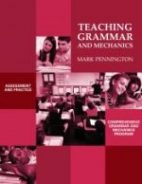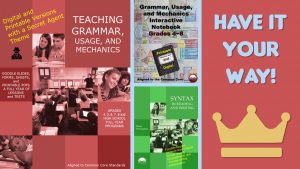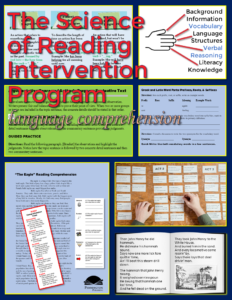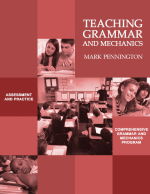
Hint: V Means 5
Teachers are well acquainted with different note-taking structures: outline, Cornell, boxing, charting, and mapping. Each has pros and cons for students taking notes from lectures or texts. However, the most commonly used structure for published materials is the alphanumeric outline. Students need to understand the hierarchy of the letter and number symbols to properly read and interpret these structured summaries. Plus, students need to know the Roman numerals.
Alphanumeric Outlines and Using Roman Numerals
Common Core Language Standard 2
Learning how to take notes from reading and lectures is essential to your success as a student. Notes are summaries of the key ideas and include main points, major details, and minor details. We often use symbols to represent these levels of organization.
Today’s mechanics lesson is on using Roman numerals in alphanumeric outlines to indicate levels of ideas.
Now let’s read the mechanics lesson, study the examples. and complete the practice exercises.
Alphanumeric Outlines use numbers, letters, and periods to organize information. The first letter of the word, group of words, or sentence that follows each symbol is capitalized.
- Main ideas are listed as Roman numerals on the left margin and are followed by periods. Each Roman numeral can be repeated up to three times in a row. Examples: For 1–10 I. II. III. IV. V. VI. VII. VIII. IX. X.
- Major details are listed as capital letters and are indented on the lines below the main ideas. Major details modify the main ideas. Modify means to describe, change, or limit. The Arabic numerals are capitalized and are followed by periods. Examples: A., B., C.
- The first minor detail modifies the major detail and is double indented on the next line. It begins with the Arabic numeral 1 followed by a period.
- The second minor detail is double indented on the next line and listed as 2.
Now circle or highlight what is right and revise what is wrong according to the lesson.
Practice: The sixth main idea is IV; the fourth major detail is d; and the third minor detail is 3.
Let’s check the Practice Answers.
Mechanics Practice Answers: The sixth main idea is VI; the fourth major detail is D; and the third minor detail is 3.
Now let’s apply what we have learned.
Writing Application: Write your own alphanumeric outline to describe your favorite ice cream flavors.
Lesson Extension
By tradition, movies include Roman numerals to indicate the year in which the movie was released. To determine the year, you’ve got to know a few more symbols. M = 1,000; D = 500; C = 100; and L = 50.
Example: MDCDLXXXVI = MD (1,000 + 500 = 1,500); CD (500 – 100 = 400); LXXX (50 + 30 = 80); VI = 6 or 1986.
Practice: Write the year of release for these Academy Award winning movies in Arabic numerals:
- Gone with the Wind: MCMXLI
- Citizen Kane: MCMXLI
- Titanic: MCMXCVII
- Little Women: MMXIX
Bonus
What is the longest Roman numeral between 0 B.C.E. and this year?
This writing opener is part of a comprehensive language conventions lesson from the Grammar, Mechanics, Spelling, and Vocabulary Grades 4‒8 programs.
Practice Answers:
- Gone with the Wind: 1939
- Citizen Kane: 1941
- Titanic: 1997
- Little Women: 2019
Bonus: MDCCCLXXXVIII (1888)
Check out this great Roman numerals converter: https://www.rapidtables.com/convert/number/roman-numerals-converter.html
*****

Teaching Grammar and Mechanics Grades 4, 5, 6, 7, 8, and High School Programs
I’m Mark Pennington, author of the full-year interactive grammar notebooks, grammar literacy centers, and the traditional grade-level 4, 5, 6, 7, 8 and high school Teaching Grammar and Mechanics programs. Teaching Grammar and Mechanics includes 56 (64 for high school) interactive language conventions lessons, designed for twice-per-week direct instruction in the grade-level grammar, usage, and mechanics standards. The scripted lessons (perfect for the grammatically-challenged teacher) are formatted for classroom display. Standards review, definitions and examples, practice and error analysis, simple sentence diagrams, mentor texts with writing applications, and formative assessments are woven into every 25-minute lesson. The program also includes the Diagnostic Grammar, Usage, and Mechanics Assessments with corresponding worksheets to help students catch up, while they keep up with grade-level, standards-aligned instruction.
Read what teachers are saying about this comprehensive program:
The most comprehensive and easy to teach grammar, mechanics, spelling, and vocabulary program. I’m teaching all of the grade-level standards and remediating previous grade-level standards. The no-prep and minimal correction design of this program really respects a teacher’s time. At last, I’m teaching an integrated program–not a hodge-podge collection of DOL grammar, spelling and vocabulary lists, and assorted worksheets. I see measurable progress with both my grade-level and intervention students. BTW… I love the scripted lessons!
─Julie Villenueve
Grammar/Mechanics
Alphanumeric Outlines, Cornell Notes, formal outlines, grammar, Mark Pennington, notetaking, outlines, pennington publishing, Roman numerals, Teaching Grammar and Mechanics


 In 2001, Dr. Hollis Scarborough, a developmental psychologist, helped parents and teachers visualize the complexity, interconnectedness, and development of skilled reading over time with her reading rope infographic. The reading rope splits into two major strands: an upper language comprehension strand strand and a lower word recognition strand. Unlike other posts, I won’t share the visual to respect the good doctor’s copyright. I’ve spoken to Hollis and she is rightfully protective of that unaltered image!
In 2001, Dr. Hollis Scarborough, a developmental psychologist, helped parents and teachers visualize the complexity, interconnectedness, and development of skilled reading over time with her reading rope infographic. The reading rope splits into two major strands: an upper language comprehension strand strand and a lower word recognition strand. Unlike other posts, I won’t share the visual to respect the good doctor’s copyright. I’ve spoken to Hollis and she is rightfully protective of that unaltered image!















